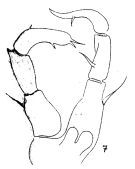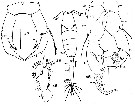|
|
 |
Fiche d'espèce de Copépode |
|
|
Calanoida ( Ordre ) |
|
|
|
Diaptomoidea ( Superfamille ) |
|
|
|
Acartiidae ( Famille ) |
|
|
|
Acartiella ( Genre ) |
|
|
| |
Acartiella gravelyi Sewell, 1919 (F,M) | |
| | | | | | | Syn.: | Acartia (Acartiella) gravelyi : Sewell, 1932 (p.393); 1948 (p.324, 429); Wellershaus, 1969 (p.267, 270, figs.F,M); Silas, 1972 (p.650); Mauchline, 1998 (tab.8) | | | | Ref.: | | | Sewell, 1919 (p.10, figs.F,M); 1948 (p.324); Goswami & Goswami, 1974 (p.109, fig. caryotypes); Barthélémy, 1999 (p.857, 860, figs.F) |  issued from : R.B.S. Sewell in Rec. Indian Mus., (1918) 1919, XYI. [Pl.X, Figs.1, 4-5]. Female (from Chilka Lake): 1, A2; 4, Mxp; 5, P5. Nota: Head and 1st thoracic segment separate, 4th and 5th separate. Rostrum absent. Posterior thoracic margin rounded and unarmed. Caudal rami asymmetrical, the right being the longer. Proportional lengths of urosomites and furca 35:41:5:19 = 100. Genital swelling forms a well-marked projection on the ventral aspect. A1 20-segmented (segments 2-4, 5-6, 8-9, 13-14 fused, segment 15 partially fused with the preceding), many of the segments bear oblique rows of fine hair-like spines on their posterior surface. The basal segment of Mxp is armed with a row of 10-12 spines P5 consists of a basal segment bearing an external seta, and a single-segmented exopod and endopod; the exopod is curved and ends in a sharp point, about mid-way along its external margin is 1 small spine, and the distal 4th of the inner margin is finely serrated; the endopod is about ½ the length of the exopod and also terminates in a sharp point, and on the distal part of the external margin bears 4 teeth.
|
 issued from : R.B.S. Sewell in Rec. Indian Mus., (1918) 1919, XYI. [Pl.IX, Fig.7]. Male: 7, P5. Nota: Proportional length of cephalothorax and abdomen 64.6:35.4. Proportional lengths of urosomites and furca 11 : 22 : 21 : 11 : 3 : 32 = 100. Caudal rami slightly asymmetrical, the right ramus being slightly the longer. Righr A1 forms a grasping organ, 16-segmented (segments 2-4, 8-10, 19-21 and 22-25 fused). Each leg of P5 consists of a single ramus;, the right leg 4-segmented, of these the basal one is produced distally in a pair of rounded wing-like flaps which overlap the proximal part of the next segment; the left leg with basal segment plus 3 segments.
|
 Issued from : S. Wellershaus in Veröff. Inst. Meeresforsch. Bremerh., 1969, 11 (2). [p.266, Fig.45-48]. Female (from Cochin Backwater, India): 47, P5 (teeth on endopod can only be seen with difficulty); 48, habitus (dorsal; blue pigmentation black). Nota: Ratio prosome : urosome = 1.5; Proportions of the urosomal segments 37 : 38: 5 : right caudal ramus = 20 (left = 15 %). Male: 45, P5; 46, A2. Nota: Ratio prosome : urosome 1.7. Proportions of the abdominal segments plus caudal rami 10 : 20 : 19 : 12 : 6 : caudal rami 33 (right side ), 27 (left side
Scale : single line = 0.1 mm ; double line = 0.05 mm.
|
 issued from : R.-M. Bathélémy in J. Mar. Biol. Ass. U.K., 1999, 79. [p.858, Fig.1, G]. Scanning electon miccrograph. Female: G, genital double-somite (ventral). Scale bar: 0.030 mm. Symbols: gp = gonoporal plate; arrowhead = cuticular fold limiting the genital area; small arrow = cuticular excrescence on the septum.
| | | | | Ref. compl.: | | | Madhupratap & Haridas, 1986 (p.105, tab.2); Tiwari & Nair, 1993 (p.67); Ramaiah & Nair, 1997 (tab.1); Achuthankutty & al., 1998 (p.1, Table 2, seasonal abundance vs monsoon); Madhu & al., 2007 (p.54, Table 4, abundance vs monsoon) | | | | NZ: | 1 | | |
|
Carte de distribution de Acartiella gravelyi par zones géographiques
|
| | | | | | | Loc: | | | India (Bombay, Goa, Cochin, Kerala) | | | | N: | 6 | | | | Lg.: | | | (83) F: 1,4; M: 1,16; (172) F: 1,22; M: 1,12; {F: 1,22-1,40; M: 1,12-1,16} | | | | Rem.: | estuaries. Brackish.
Voir aussi les remarques en anglais | | | Dernière mise à jour : 15/12/2017 | |
|
|
 Toute utilisation de ce site pour une publication sera mentionnée avec la référence suivante : Toute utilisation de ce site pour une publication sera mentionnée avec la référence suivante :
Razouls C., Desreumaux N., Kouwenberg J. et de Bovée F., 2005-2025. - Biodiversité des Copépodes planctoniques marins (morphologie, répartition géographique et données biologiques). Sorbonne Université, CNRS. Disponible sur http://copepodes.obs-banyuls.fr [Accédé le 04 décembre 2025] © copyright 2005-2025 Sorbonne Université, CNRS
|
|
 |
 |






